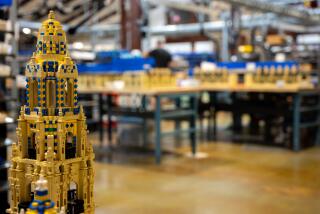In ‘augmented reality,’ toy makers see a way to compete with apps
- Share via
Unable to resist the “Try me!” sign, 8-year-old Julian Rivas held up a box containing the Star Wars Death Star Lego set in front of a yellow kiosk and was blown away.
On the kiosk’s TV screen, Rivas could see not only himself holding the box but also a 3-D image of the Death Star as it would look had he built it himself. Better yet, when Rivas rotated the box, the Death Star moved with it, revealing miniature guards sparring with light sabers and laser guns firing into space.
“It was amazing,” Rivas said as he put the box back down at the Glendale Lego store. “I could see the little Lego people walking around. And I heard R2-D2.”
The kiosk was equipped with a small camera and one of the latest technologies to hit the toy market: augmented reality.
The technology, which superimposes digital images, video or animation over a user’s live surroundings, has been around for several years. Think the yellow first-down line during a football game on TV.
But this holiday season, it made its way into retail stores in a big way as toy makers sought new ways to sell more products.
In an age when even toddlers use tablets and smartphones, capturing children’s interest and imagination is harder than ever, toy analysts and toy makers said.
“Kids are moving very quickly past their physical toy and into the tech realm,” said Jason Moser, a toy analyst with Motley Fool, a financial information website. Children as young as 5 are outgrowing physical toys.
Karla Gomez, a stay-at-home mom who was shopping at the Lego store, said her three young sons love the Lego building blocks but fight more over the family’s single iPad. Her 5-year-old, Jordan Sutherland, loves to play “Jetpack Joyride,” a free mobile app.
“They want the touch-screen stuff,” she said.
Mobile apps, many of which are free, can keep kids entertained for hours and often have an educational focus, Moser said. These are all big wins for parents but may represent big losses for traditional toy makers.
Adding augmented reality to physical toys may help toy makers win back children who are increasingly playing with smartphones rather than Barbie dolls.
“There’s not much that’s more magic than seeing something that’s not really there, from the perspective of a kid,” said Sean McGowan, a toy industry analyst at Needham & Co.
Today, shoppers can peer inside 3-D models of Ikea furniture by waving their smartphone at a paper catalog, or point their phones down a residential street and see which houses are for sale and for how much. Google’s highly anticipated augmented reality project, Google Glass, is due out in 2013 and promises cyborg-level knowledge in a wearable format.
But when it comes to playtime, the technology has mostly been used to market toys. Lego, for instance, uses the “Digital Box” kiosks to entice children into buying the Lego sets. Wal-Mart recently released its Web-Slinger app that enables children to see Spider-Man battle the Lizard in 3-D on a mobile device, but only if they point the device’s camera at a Spider-Man DVD package and an accompanying pizza box.
A few toys incorporating augmented reality technology also began appearing on toy store shelves last year.
WowWee, a company specializing in high-tech toys, rolled out a foam plane that mounts in front of the mobile device’s camera. On the screen, the player can see the plane superimposed on various aerial combat scenarios. The player controls the plane by moving the device.
German puzzle maker Ravensburger has added augmented reality apps that can make 3-D animals jump out from a puzzle of an African safari scene when a camera is aimed at it. And a number of laser tag toys allow smartphones to be mounted on plastic guns. Pointing the gun at a bookshelf or sofa, for example, might prompt virtual alien attackers to appear on the smartphone screen.
But analysts said few of the games had the “wow” factor that would convince them that the latest trend has staying power.
“Why do I need a piece of plastic to push the buttons when I could hold my phone or tablet out and do it myself?” McGowan said. “You need to convince people that something really extraordinary is going on to get people to part with their money.”
For companies willing to try, challenges await.
For one, augmented reality apps are expensive to develop, said Laurie Schacht, co-publisher of the Toy Insider. Many toy makers don’t want to invest in the technology, especially when consumers expect mobile apps to be provided free.
Parents succumbing to a child’s demands for techie devices like tablets also may not want to spend more money on real toys to augment virtual play. And there’s always the parental skepticism of melding a $20 plastic toy with a $300 mobile device.
“I think it’s going to take a few years before we see something that’s really awesome,” Schacht said. But, she said, the outcome can be magical for kids.
Sony PlayStation’s recently launched “Book of Spells” game, for example, turns a blank book into an interactive pop-up book of magic, complete with Harry Potter magic wand, floating figures and orbs of light.
“All of a sudden, you’re playing in that magical world, and you’re seeing yourself the whole time,” Schacht said.
Industry expectations for augmented reality’s potential are sky-high.
Tech research firm Juniper predicted that revenue from augmented reality apps could reach $300 million this year, up from a projected $82 million in 2012. By 2017, the firm predicted, more than 2.5 billion augmented reality apps will be downloaded, bringing in $5.2 billion in revenue. Another research firm, Semico, said more than 864 million high-end cellphones would be augmented-reality-enabled by 2014.
But for many consumers, many of whom are not aware of the technology, the jury is still out.
For Jose Casas, 44, watching a Lego box come to life made him want the $399 Death Star set even more. “It’s about imagination, dude,” the self-proclaimed “kid at heart” said.
His friend Marcos Najera, 40, was unconvinced. Shopping for his 8-year-old nephew, Najera briefly picked up another Star Wars Lego set, then set it down. “It’s still a $60 toy.”
More to Read
Inside the business of entertainment
The Wide Shot brings you news, analysis and insights on everything from streaming wars to production — and what it all means for the future.
You may occasionally receive promotional content from the Los Angeles Times.











